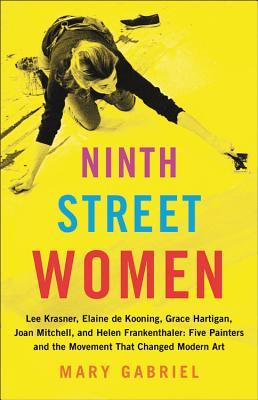Jeffrey Keeten's Reviews > Ninth Street Women: Lee Krasner, Elaine de Kooning, Grace Hartigan, Joan Mitchell, and Helen Frankenthaler: Five Painters and the Movement That Changed Modern Art
Ninth Street Women: Lee Krasner, Elaine de Kooning, Grace Hartigan, Joan Mitchell, and Helen Frankenthaler: Five Painters and the Movement That Changed Modern Art
by

by

”All artists succumb to self-doubt; it is the handmaiden of creation. For a woman, however, whether in Virginia Woolf’s early twentieth-century England or Joan Mitchell’s 1950’s New York, that doubt would have been the result of forces both creative and social. Of the latter, Woolf wrote,
’The indifference of the world which Keats and Flaubert and other men of genius have found so hard to bear was in her case not indifference but hostility. The world did not say to her as it said to them, Write if you choose; it makes no difference to me. The world said with a guffaw, Write? What’s the good of your writing?’
Many decades later, Joan would put her own salty spin on the same sentiment.
’How did I feel, like how? I felt, you know, when I was discouraged I wondered if really women couldn’t paint, the way all the men said they couldn’t paint. But then at other times I said, ‘Fuck them’, you know.’
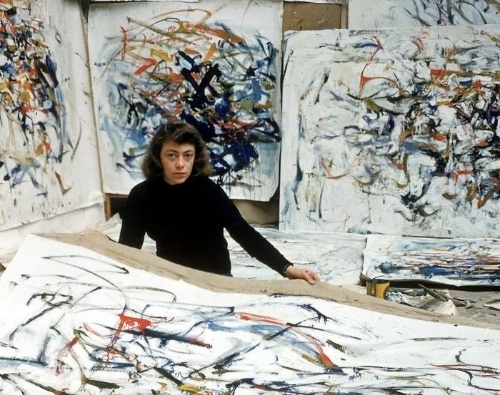
Joan Mitchell in studio.
Mary Gabriel has written a biography of five amazingly talented women: Lee Krasner, Elaine de Kooning, Grace Hartigan, Joan Mitchell, and Helen Frankenthaler. However, his book is so much more than just the lives of these women. The influence of world events on people, especially creative people, can not be separated from the accomplishments of those who painted, wrote, and composed, who were attempting to make sense of these events with their brushstrokes, words, and music.
Picasso is debatably the most famous and most influential painter of all time. His painting of Guernica is without question one of the most important paintings of all time. He brought painting forward to a different place, and in my mind, the Abstract Expressionist painters spent their lives chasing after Picasso. In the process, they broke every rule, destroyed every boundary, and remade art in their image.
We call a male artist a painter without even thinking about it. We still call female artist ‘women painters.’ By the end of this book, the five women will convince you that women deserve to be called painters without designation of their sex.
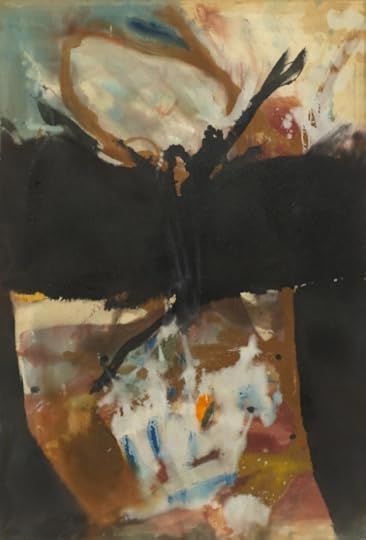
Trojan Gates by Helen Frankenthaler. I love this painting!
Now the men are here, as well. In fact, two of the five women married the two most famous men of the New York Abstract Expressionist movement. Lee Krasner married Jackson Pollock and spent the rest of his life trying to keep the man alive. She always felt like she had a ”comet by the tail.” Pollock blew everything up in the art world, but in the process he destroyed his own life and adversely affected the lives of those who cared about him. Helen Frankenthaler summed up his influence on other painters. ”Soaking it all in, Helen realized something she had not understood when merely viewing Jackson’s work on a gallery wall. Pollock didn’t paint with his hands or wrists or even his arms, he painted with his whole body. Helen saw the potential for her own work in his method. She, too, wanted to engage her entire person in her paintings, not merely the delicate extreminites that held a brush. She did not want to paint on a canvas, she wanted to paint in it.”
Elaine married Willem (Bill) de Kooning, and as much as Lee struggled to find her artistic place with Pollock, Elaine had similar struggles with her relationship with de Kooning. Their marriage was beset with infidelity, artistic jealousy, and poverty. Most of the painters struggled to feed and shelter themselves and frequently had to find jobs that took them away from their canvases. Elaine wrote art reviews for magazines to allow Bill the freedom to keep searching for his voice, his expression in the strokes of his brush. Her writing helped define the Abstract Expressionist movement. ”’Whenever Hollywood does a movie on artists they don’t know how to deal with what drives an artist,’ Elaine said. ‘They always think an artist works toward fame. They can’t imagine the thrill of the actual work, it doesn’t occur to them. That, they feel is just on the side, and fame is the aim. Whereas it’s exactly the opposite. {Work} is the aim, and fame is a byproduct.’”
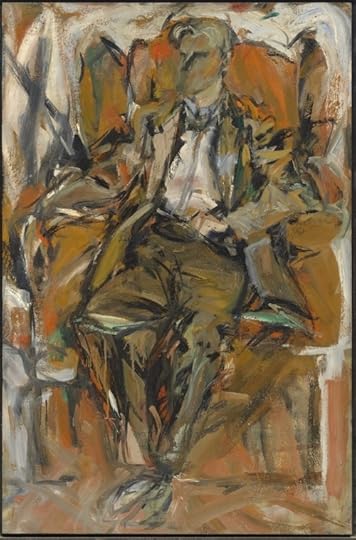
Elaine de Kooning went through a period when she was painting men, a reverse of the concept of women as muses. Why can’t men be muses as well? I absolutely love her portraits and would have loved to have seen how she would have painting me.
Gabriel covers the evolution of this art movement from the late 1920s to the early 1960s. Prohibition, the swinging 1930s, the emergence of Jazz, WW2 when the intellectuals of Europe were forced out of their countries to find a home in New York, and McCarthyism all had influence on the minds and actions of the artists. Amongst so much turmoil, is it any wonder that art needed to find new ways to express the torment?
”The world about us would be desolate except for the world within us.”
-----Wallace Stevens
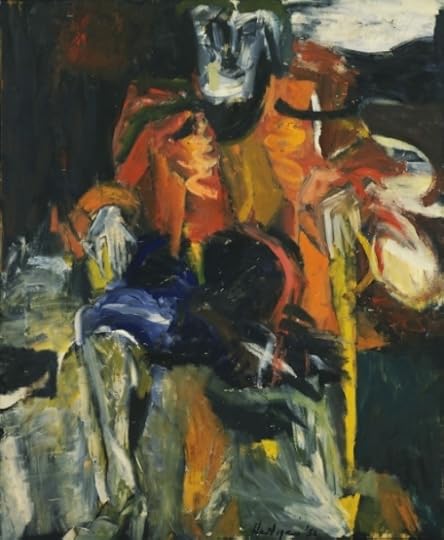
Grace Hartigan’s Persian Jacket. Awesome!
Grace Hartigan was in love with the poet Frank O’Hara, and he with her. ”If a homosexual and a heterosexual could be in love, it was falling in love.” His poems influenced her art, but I felt that her painting may have influenced his poetry even more. Those who chose to love Grace or Frank had to understand that their relationship with the artist or poet was never going to eclipse what Grace and Frank felt for one another. I found their relationship exceedingly intriguing because so much of the definition of a relationship is defined by having sex. They were closer than siblings. Closer than lovers. They were frequently confused by the boundaries of their odd relationship and tempted to consummate it in the normal fashion, but the fear of destroying the precious, fragile bonds of what they had together always kept them from provoking fate.
Jackson Pollock was the first celebrity artist of the movement. Lee Krasner worked tirelessly to promote his art. She wasn’t just doing it for Pollock. She knew that women abstract expressionists had no chance to ever be recognized if the men were not recognized first. She put aside her own art for long periods of time to champion Pollock. Her other, on going concern with the “comet” was keeping him alive. His epic drinking was a constant threat to his health and his legacy. She was successful at least in preserving his legacy, but I can’t help wondering if the cost to her art was too large a price to pay.
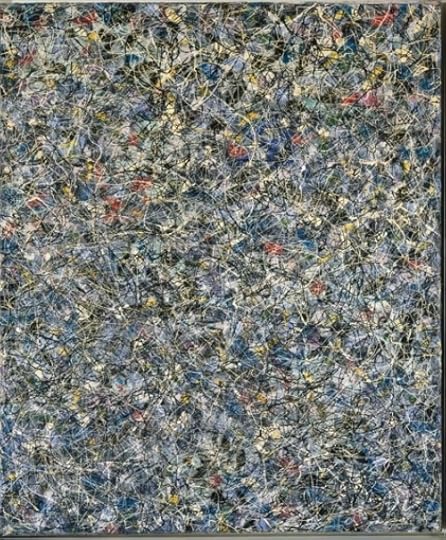
Lee Krasner, Untitled 1948. The more I look into this painting it becomes a maze for my mind.
I read this book every morning with a hot cup of Earl Grey, steaming in my hand. It was such an inspirational way to start the day by reading about the trials and tribulations of these five women as they forged a place for themselves in a profession that deigned to recognize the importance of their work. They persevered because they had no choice. The same fire that drove Pollock and de Kooning to create their masterpieces was an eternal flame in their bellies as well. They painted until the final veil descended.
Mary Gabriel was a finalist for the Pulitzer Prize for her book Love and Capital, and I wouldn’t be surprised if she finds herself back on that list with this book. I knew the names of these five women before starting to read this book, but their work was unknown to me. If I have seen their art, it was without truly seeing it. With all these new reference points and now knowing their place in history, I can look upon their art with eyes properly focused to see beyond just color and composition, but with reverence for how that piece of art was created and the battle it took for that artwork to even be hung on the wall of any museum.
This is without a doubt the most influential and enjoyable read of the year for me.
I want to thank Little, Brown, and Company for sending me a free copy in exchange for an honest review.
If you wish to see more of my most recent book and movie reviews, visit http://www.jeffreykeeten.com
I also have a Facebook blogger page at: https://www.facebook.com/JeffreyKeeten
’The indifference of the world which Keats and Flaubert and other men of genius have found so hard to bear was in her case not indifference but hostility. The world did not say to her as it said to them, Write if you choose; it makes no difference to me. The world said with a guffaw, Write? What’s the good of your writing?’
Many decades later, Joan would put her own salty spin on the same sentiment.
’How did I feel, like how? I felt, you know, when I was discouraged I wondered if really women couldn’t paint, the way all the men said they couldn’t paint. But then at other times I said, ‘Fuck them’, you know.’

Joan Mitchell in studio.
Mary Gabriel has written a biography of five amazingly talented women: Lee Krasner, Elaine de Kooning, Grace Hartigan, Joan Mitchell, and Helen Frankenthaler. However, his book is so much more than just the lives of these women. The influence of world events on people, especially creative people, can not be separated from the accomplishments of those who painted, wrote, and composed, who were attempting to make sense of these events with their brushstrokes, words, and music.
Picasso is debatably the most famous and most influential painter of all time. His painting of Guernica is without question one of the most important paintings of all time. He brought painting forward to a different place, and in my mind, the Abstract Expressionist painters spent their lives chasing after Picasso. In the process, they broke every rule, destroyed every boundary, and remade art in their image.
We call a male artist a painter without even thinking about it. We still call female artist ‘women painters.’ By the end of this book, the five women will convince you that women deserve to be called painters without designation of their sex.

Trojan Gates by Helen Frankenthaler. I love this painting!
Now the men are here, as well. In fact, two of the five women married the two most famous men of the New York Abstract Expressionist movement. Lee Krasner married Jackson Pollock and spent the rest of his life trying to keep the man alive. She always felt like she had a ”comet by the tail.” Pollock blew everything up in the art world, but in the process he destroyed his own life and adversely affected the lives of those who cared about him. Helen Frankenthaler summed up his influence on other painters. ”Soaking it all in, Helen realized something she had not understood when merely viewing Jackson’s work on a gallery wall. Pollock didn’t paint with his hands or wrists or even his arms, he painted with his whole body. Helen saw the potential for her own work in his method. She, too, wanted to engage her entire person in her paintings, not merely the delicate extreminites that held a brush. She did not want to paint on a canvas, she wanted to paint in it.”
Elaine married Willem (Bill) de Kooning, and as much as Lee struggled to find her artistic place with Pollock, Elaine had similar struggles with her relationship with de Kooning. Their marriage was beset with infidelity, artistic jealousy, and poverty. Most of the painters struggled to feed and shelter themselves and frequently had to find jobs that took them away from their canvases. Elaine wrote art reviews for magazines to allow Bill the freedom to keep searching for his voice, his expression in the strokes of his brush. Her writing helped define the Abstract Expressionist movement. ”’Whenever Hollywood does a movie on artists they don’t know how to deal with what drives an artist,’ Elaine said. ‘They always think an artist works toward fame. They can’t imagine the thrill of the actual work, it doesn’t occur to them. That, they feel is just on the side, and fame is the aim. Whereas it’s exactly the opposite. {Work} is the aim, and fame is a byproduct.’”

Elaine de Kooning went through a period when she was painting men, a reverse of the concept of women as muses. Why can’t men be muses as well? I absolutely love her portraits and would have loved to have seen how she would have painting me.
Gabriel covers the evolution of this art movement from the late 1920s to the early 1960s. Prohibition, the swinging 1930s, the emergence of Jazz, WW2 when the intellectuals of Europe were forced out of their countries to find a home in New York, and McCarthyism all had influence on the minds and actions of the artists. Amongst so much turmoil, is it any wonder that art needed to find new ways to express the torment?
”The world about us would be desolate except for the world within us.”
-----Wallace Stevens

Grace Hartigan’s Persian Jacket. Awesome!
Grace Hartigan was in love with the poet Frank O’Hara, and he with her. ”If a homosexual and a heterosexual could be in love, it was falling in love.” His poems influenced her art, but I felt that her painting may have influenced his poetry even more. Those who chose to love Grace or Frank had to understand that their relationship with the artist or poet was never going to eclipse what Grace and Frank felt for one another. I found their relationship exceedingly intriguing because so much of the definition of a relationship is defined by having sex. They were closer than siblings. Closer than lovers. They were frequently confused by the boundaries of their odd relationship and tempted to consummate it in the normal fashion, but the fear of destroying the precious, fragile bonds of what they had together always kept them from provoking fate.
Jackson Pollock was the first celebrity artist of the movement. Lee Krasner worked tirelessly to promote his art. She wasn’t just doing it for Pollock. She knew that women abstract expressionists had no chance to ever be recognized if the men were not recognized first. She put aside her own art for long periods of time to champion Pollock. Her other, on going concern with the “comet” was keeping him alive. His epic drinking was a constant threat to his health and his legacy. She was successful at least in preserving his legacy, but I can’t help wondering if the cost to her art was too large a price to pay.

Lee Krasner, Untitled 1948. The more I look into this painting it becomes a maze for my mind.
I read this book every morning with a hot cup of Earl Grey, steaming in my hand. It was such an inspirational way to start the day by reading about the trials and tribulations of these five women as they forged a place for themselves in a profession that deigned to recognize the importance of their work. They persevered because they had no choice. The same fire that drove Pollock and de Kooning to create their masterpieces was an eternal flame in their bellies as well. They painted until the final veil descended.
Mary Gabriel was a finalist for the Pulitzer Prize for her book Love and Capital, and I wouldn’t be surprised if she finds herself back on that list with this book. I knew the names of these five women before starting to read this book, but their work was unknown to me. If I have seen their art, it was without truly seeing it. With all these new reference points and now knowing their place in history, I can look upon their art with eyes properly focused to see beyond just color and composition, but with reverence for how that piece of art was created and the battle it took for that artwork to even be hung on the wall of any museum.
This is without a doubt the most influential and enjoyable read of the year for me.
I want to thank Little, Brown, and Company for sending me a free copy in exchange for an honest review.
If you wish to see more of my most recent book and movie reviews, visit http://www.jeffreykeeten.com
I also have a Facebook blogger page at: https://www.facebook.com/JeffreyKeeten
Sign into Goodreads to see if any of your friends have read
Ninth Street Women.
Sign In »
Reading Progress
November 11, 2018
–
Started Reading
November 11, 2018
– Shelved
November 11, 2018
– Shelved as:
nonfiction
November 11, 2018
– Shelved as:
artists
December 2, 2018
–
Finished Reading
Comments Showing 1-18 of 18 (18 new)
date newest »
newest »
 newest »
newest »
message 1:
by
j e w e l s
(new)
Dec 06, 2018 06:27PM
 fascinating! thanks for the review, Jeffrey!
fascinating! thanks for the review, Jeffrey!
reply
|
flag
 j e w e l s wrote: "fascinating! thanks for the review, Jeffrey!"
j e w e l s wrote: "fascinating! thanks for the review, Jeffrey!"Thanks Jewels! I feel like an expert on the Abstract Expressionism movement by just reading this book! Epic!
 Lorna wrote: "Beautiful review Jeffrey, on so many levels, of this exciting time.in history. Thank you."
Lorna wrote: "Beautiful review Jeffrey, on so many levels, of this exciting time.in history. Thank you."Thank you Lorna! You are most welcome! The highs and lows of this period of time pushed the creativity levels of artists, writers, and musicians to new heights.
 I actually miss sitting down with this book every morning with my tea and reading a few chapters. I really hope you enjoy it as much as I did Cheryl!
I actually miss sitting down with this book every morning with my tea and reading a few chapters. I really hope you enjoy it as much as I did Cheryl!
 I also am so enjoying this book and loved your review which beautifully stated my own thoughts and enthusiasm. I will follow you on Facebook.
I also am so enjoying this book and loved your review which beautifully stated my own thoughts and enthusiasm. I will follow you on Facebook.
 Hattie wrote: "I also am so enjoying this book and loved your review which beautifully stated my own thoughts and enthusiasm. I will follow you on Facebook."
Hattie wrote: "I also am so enjoying this book and loved your review which beautifully stated my own thoughts and enthusiasm. I will follow you on Facebook."Thanks Hattie! Wonderful book! I wish more people would read this book. It was so much more than just art, but the look inside the art movement is like living the history for ourselves.
 Lovely review, Jeffrey. Women have treated like that right from the outbreak of civilization, we have a prejudice against them deep down our consciousness which, perhaps, we may not be even aware of, consciously. The book looks quite intriguing, adding it. Thanks for the review :)
Lovely review, Jeffrey. Women have treated like that right from the outbreak of civilization, we have a prejudice against them deep down our consciousness which, perhaps, we may not be even aware of, consciously. The book looks quite intriguing, adding it. Thanks for the review :)
 Gaurav wrote: "Lovely review, Jeffrey. Women have treated like that right from the outbreak of civilization, we have a prejudice against them deep down our consciousness which, perhaps, we may not be even aware o..."
Gaurav wrote: "Lovely review, Jeffrey. Women have treated like that right from the outbreak of civilization, we have a prejudice against them deep down our consciousness which, perhaps, we may not be even aware o..."Thanks Gaurav! I believe that religion has played a large role in poisoning men's minds about women. There are too many stories about women consorting with serpents or betraying men etc. These women in this book did their level best to break the glass ceilings regarding women in art and succeeded to some extent, but even today the household names in art are still a long list of males.
 WOW. After reading your in depth review & comments, I look fwd to reading Ninth Street Women and your blog! Noxious patriarchy still seeps throughout history gaslighting & victimizing vulnerable women & minorities. It’s time for women to shed our own mysogynistic bad habits, partner with strong enlightened men & support women leaders in all institutions. Power hungry patriarchal men have been massively f’ing things up for too long. Timely thought: Vote4 women leaders & senators who unite us, with their skills & sincere compassion for others. Women are vital to human survival. I’m getting the book today, to read during America’s historic election of women leaders.
WOW. After reading your in depth review & comments, I look fwd to reading Ninth Street Women and your blog! Noxious patriarchy still seeps throughout history gaslighting & victimizing vulnerable women & minorities. It’s time for women to shed our own mysogynistic bad habits, partner with strong enlightened men & support women leaders in all institutions. Power hungry patriarchal men have been massively f’ing things up for too long. Timely thought: Vote4 women leaders & senators who unite us, with their skills & sincere compassion for others. Women are vital to human survival. I’m getting the book today, to read during America’s historic election of women leaders.
 Leslie wrote: "WOW. After reading your in depth review & comments, I look fwd to reading Ninth Street Women and your blog! Noxious patriarchy still seeps throughout history gaslighting & victimizing vulnerable wo..."
Leslie wrote: "WOW. After reading your in depth review & comments, I look fwd to reading Ninth Street Women and your blog! Noxious patriarchy still seeps throughout history gaslighting & victimizing vulnerable wo..."I think the best place for women to really start exerting their influence is at the ballot box. More white women voted for Trump than voted for Clinton. Certainly women would have benefited from a woman finally breaking that huge glass ceiling. That election went beyond politics for women and it was baffling to see the results. The suffragettes who worked so hard for the vote would be stunned at the state of affairs today. With women making up over half of the voting population how are politics still so heavily dominated by men? Maybe women leaders need to work less on changing men's minds and work more on getting women on the same page. So I totally agree with your assessment Leslie!
This book is incredible and I only covered a fraction of what I wanted to write about in the review. I felt so enlightened about women painters. Tragic how little attention was paid to them, but regardless of the lack of opportunity and fame they...had...to...paint.
 Jeffrey, thanks for this review. As a painter myself, I am in awe of these painters, love their work. I can’t wait to get my copy!
Jeffrey, thanks for this review. As a painter myself, I am in awe of these painters, love their work. I can’t wait to get my copy!
 Smmikutowski wrote: "Jeffrey, thanks for this review. As a painter myself, I am in awe of these painters, love their work. I can’t wait to get my copy!"
Smmikutowski wrote: "Jeffrey, thanks for this review. As a painter myself, I am in awe of these painters, love their work. I can’t wait to get my copy!"You are most welcome! You are going to learn so much about these women and this movement and in the context of the history that surrounded them. Wonderful book!

